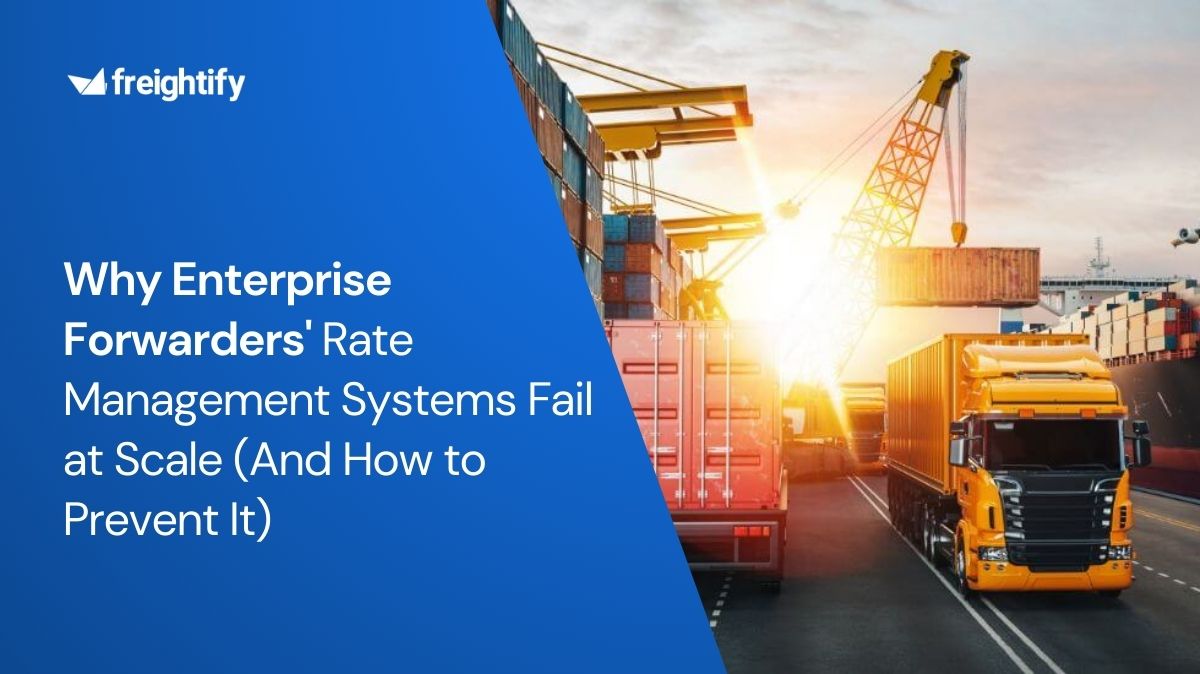With digital advancements, most businesses across various sectors have been able to automate their operations. The supply chain industry is no different. Manual dependencies have been challenging as it is not easy to maintain speed and reliability with labor-intensive processes.
By implementing digital interventions, businesses can benefit from a world of opportunities. From productivity and time-management to ease of access and communication, technological improvements in the 21st century have proven cost-effective. Similarly, with automated freight rate management systems , freight forwarders can build the flexibility to remain relevant and consistent without breaching timelines in a fast-paced world.
Freightify creates a possibility to view rates in a single SaaS-based platform – thereby keeping data real-time and constituting educated decision-making for freight forwarders.
What's in this article:-
Let us help you with your journey
Your one-stop solution to retrieve all live carrier rates & schedules in seconds!
The downside of traditional rate management systems In a conventional business process, SME freight forwarders would require the services of at least 2 to 3 sales teams to generate inquiries by visiting the customers or receiving them over telephonic requests.
These queries are then translated to the team that helps fetch quotations. The procurement team will act on these requests and manually reach out to the carriers and liners to get their rates. This is then communicated back to the inside sales team, which will finally convey the quotes to the customers to provide a rate.
By the time this cumbersome process concludes, there are high probabilities that the spot rates could be invalid as it takes up to 72 hours to complete the cycle.
There is also the likelihood of manual miscommunications and human errors while information is relayed between teams. Additionally, research says that freight forwarders are able to respond to only 60% of the received manual inquiries. Hence, the chance of a potential sale being made is rather slim.
The manual processes in a traditional freight forwarding environment depend highly on human interactions. These could come in various formats with several interpretations. As a result, the labor costs involved in these operations are hefty.
Let us not forget the humongous tasks involved in filing away all the data, including every inquiry and quote. Other teams like the billing team would also require easy access to the data. This paper-based approach requires standardized practices to ensure that data can be retrieved easily. Even then, the space and the printing costs involved are on the higher side. Similarly, when data is kept on paper or even in individual email boxes, it might not be accessible to everyone.
Ironically, there will be a lack of transparency even though the communication channels are always open.
So how can digital practices add value and streamline these complex tasks?
Digitalized strategies for complex problems By automating these manual processes, SME freight forwarders are bound to benefit from real-time data and faster communication.
The main aim of an automated rate management tool is to help sales and procurement teams turn around an inquiry and make a sale.
By using a single SaaS platform, freight forwarders can instantaneously respond to queries and provide quotes within seconds. This is a drastic improvement from the usual 24–72 hour process. The volumes that a sales team can achieve will automatically increase by reducing the time on one inquiry.
Apart from transparency, the automated rate management tool acts as a centralized data processing unit, sharing real-time data and keeping track of every transaction. Every business function can be streamlined into a single platform, and complex pricing information can be standardized. As a result, manual dependencies with filing, storing, and retrieving data can be minimized to just a click of a button.
The economics behind the business operations becomes more prudent.
The more inquiries, the more business can be won. So eventually, with an innovative digital solution, the same labor hours can be utilized towards more productive tasks that directly increase the revenue.
Cost-based savings from automating rate management Ease of use, reliability, and speed are the key factors that make using automated rate management systems (RMS) more profitable. A detailed case study reveals that after implementing RMS, the entire inside sales team can be repurposed as there won't be a requirement to collect and pass data manually across teams. Additionally, procurement teams can be effective and productive as quotes from carriers and liners will be collected in real-time using APIs and SaaS-based platforms.
In recent times, when it is hard to hire and retain quality labor, SME freight forwarders need not rely on manpower to process their inquiries. Time spent on rectifying misquotes or reconfirming rates can be eradicated entirely. Staff time can be used towards more profitable functions.
While quoting using the RMS tool, forwarders can manage margins and additional charges on the fly. Margins can be set per customer or basis of the origin/destination locations, equipment used, or carrier level. Further, the margins can be decided as a percentage or a fixed mark-up.
Quotes can be sent and received digitally round the clock and across geographies. Hence, SME forwarders need to have only specialist staff to gain sales as back-end operations are automated. This provides an opportunity to downsize labor costs by over 50%, giving SME forwarders their most significant cost minimization advantage.
Additional costs, including but not limited to printing and stationery, space for storing documents, and manual validation at the timing of billing, can also be eliminated in this process.
The RMS tools provide complete control of buying and selling prices with added services like trend analysis and reporting. Visibility is the key in a fast-paced supply chain industry. Manual dependencies cannot provide the levels of transparency that an automated RMS solution can provide, along with the crucial cost-cutting opportunities.
FAQs What is a rate management system? A rate management system is a digital tool (usually a SaaS model) that assists freight forwarders in consolidating, optimizing, and streamlining the flow of contracts and rates coming in from various providers and going to their customers. This enables their main Unique Selling Proposition as a balanced multi-carrier provider. The underlying use of this solution is to help forwarders in the logistics industry to understand better and control their purchasing and selling functions (from rate procurement to quotation stage, including rate management)
Why is there a need for RMS solutions? When spot rates increase every week in a volatile spot market (for example, in 2021), the live and updated rate procurement service that an RMS tool can offer will solve pricing issues. Forwarders will have visibility to the exact rate prevalent at a specific point in time and can make their quotations accurately. It helps take businesses globally.
What are the benefits of using a Rate Management System? Transparency and visibility are the most evident benefits of an RMS tool. It provides real-time data with worldwide coverage. It handles data centrally, processes complex pricing data, and manages quotes in different formats and currencies. The RMS tool offers several cost-cutting opportunities by providing a resilient mechanism to procure rates and make quotes quickly and accurately.
Who is benefited from an automated rate management system? As the RMS tool is integrated with all major carriers and can translate data across formats to provide updated prices, freight forwarders in the logistics industry who work across time zones and borders benefit the most.
Which processes can be automated by a rate management system? The overall product suite allows processes from rate procurement to rate management and quotation and data handling to be automated. Track and trace functions along with analytics can also be run digitally. The RMS tool can also be integrated with other TMS software using an API upload option.




















